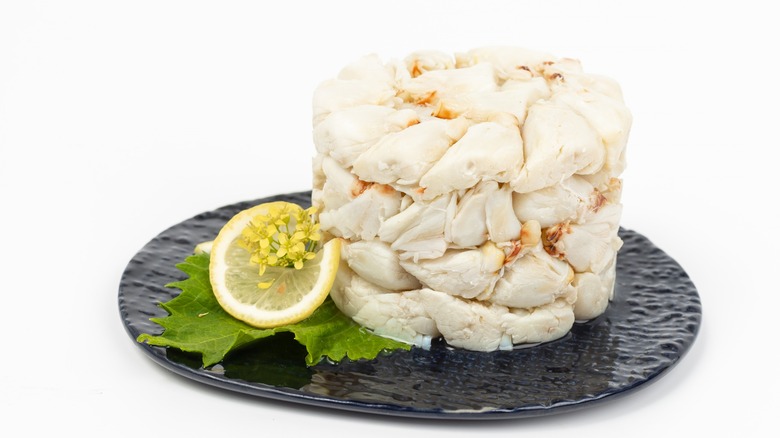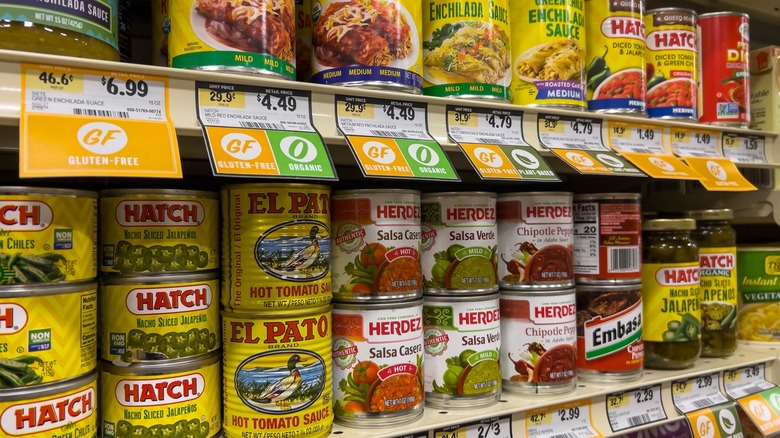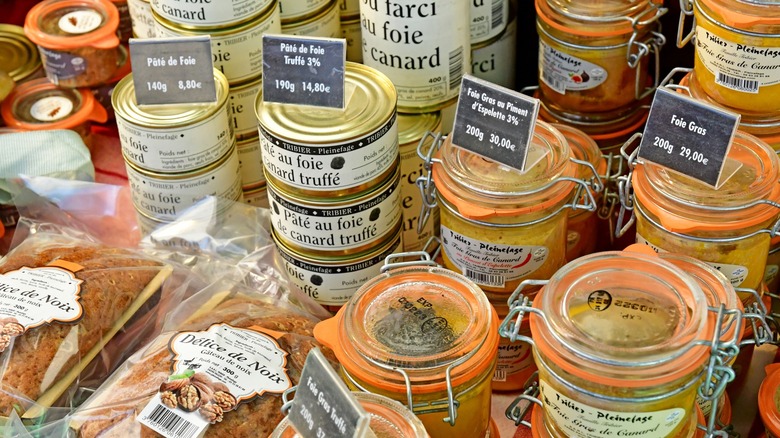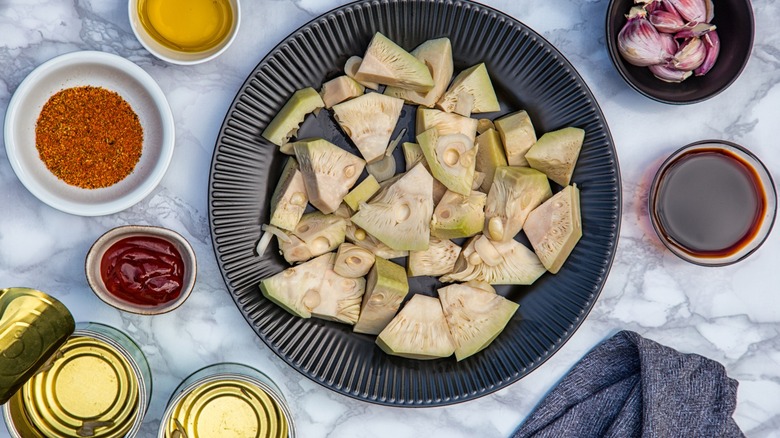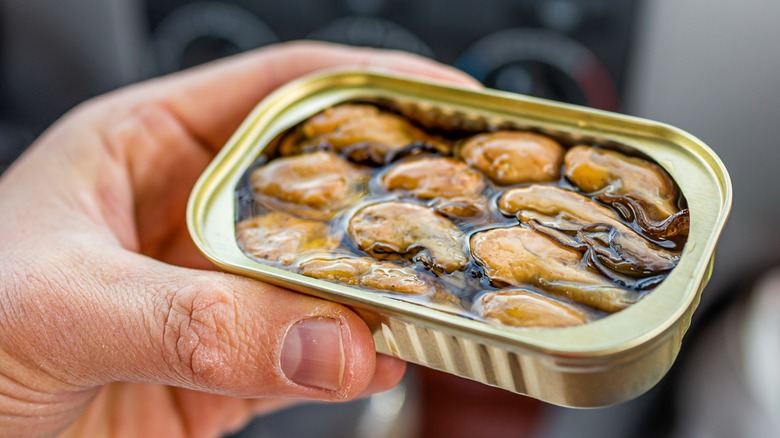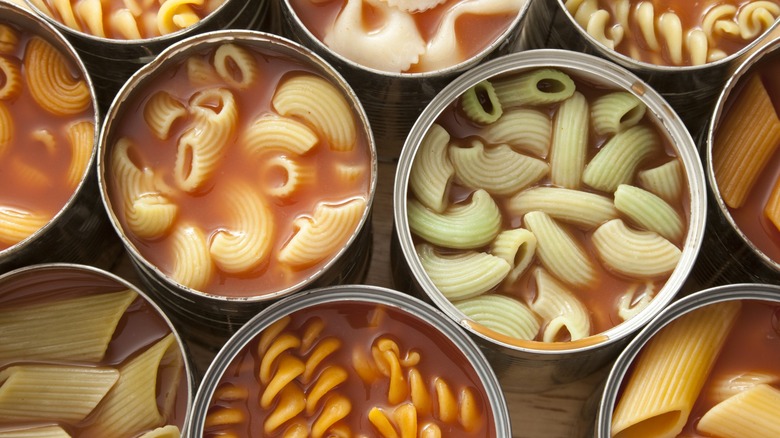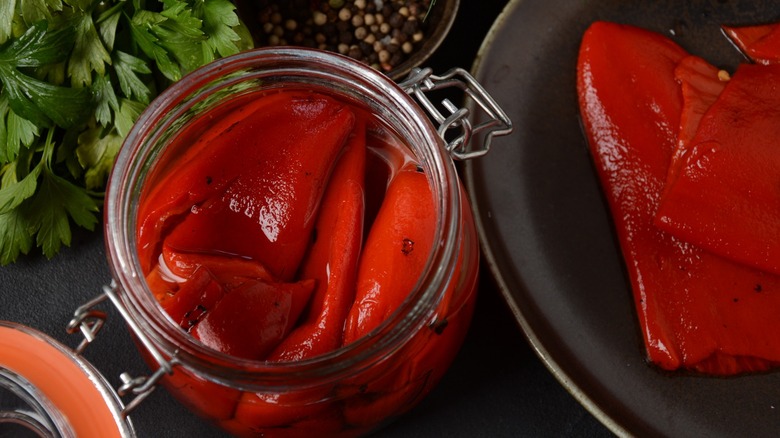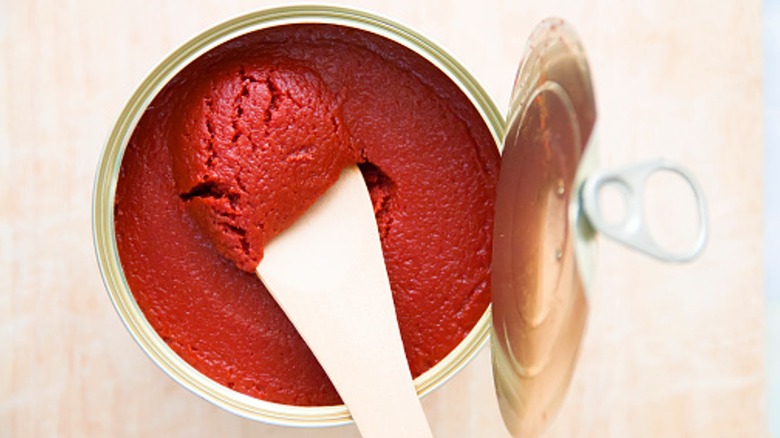17 Consistently Most Expensive Canned Foods To Buy
Many of us rely on canned pantry items for a number of reasons — longevity, storage space, and more often than not, affordability. Like everything on the market, canned foods also come in a range of prices from cheap chickpeas to eye-wateringly expensive pâtés. But there has to be a middle ground in there, for home cooks looking for ways to upgrade dinner without wasting loads of money while still saving time.
Canned food has long been a timesaver in the kitchen, along with all the aforementioned benefits. While there is still something to be said for taking the time to perfect a pot of enchilada sauce or clean and prepare a bag of mussels, we don't always have that kind of room in our schedules. Splashing out on a few more expensive items when stocking your pantry can give you an easy way to give yourself a little luxury without spending too much time or money.
Artichokes
On the surface, artichoke hearts seem pretty expensive. But, like a few other items on this list, they're a pretty good deal when you take a few things into consideration. First of all, artichokes can be a pretty big pain to prepare. While the canned version won't make a great substitute for fresh, they're a spectacular addition to pasta, pizza, charcuterie, or whizzed into a creamy dip.
They're one of the foods that made our list of canned goods you should buy; their nutritional value and ease of use outweigh the cost of a can. They're pretty good for you, with few calories or fat but packed full of fiber and vitamin C. And they're delicious, too, however you serve them. But we recommend this creamy artichoke hearts gratin with lemon and Gruyère.
Cheese
If you've never heard of canned cheese, we have news for you. There are a few brands on the market but none as beloved as Washington State University Creamery's Cougar Gold. Honestly, this stuff has a diehard following online, where people rave about the product's perfect meltability, tanginess, and longevity. This isn't the only canned cheese on the market, either. India has a version called Amul that's well-known and just as well-loved, although a little harder to find stateside.
This entry is definitely on the more expensive side, with a 30-ounce can costing you upwards of $30, according to the WSU website, but this doesn't stop fans from ordering it by the boxful. It lasts forever, works in any number of recipes, and seems like an ideal addition to our next cocktail hour spread.
Chicken bouillon
A tetra pack of stock won't cost you much but just think of the space it takes up. Unless you're spending your time making your own bone broth, you might be looking for a decent alternative. There are a few choices when it comes to stock options, from bouillon cubes to concentrated paste to powders. For the price, we can recommend concentrated paste types, like Better Than Bouillon and others.
One of the things to watch out for, however, is the amount of salt used in these versions — it can be overpowering for some. If you find that's the case, these pastes have more than enough flavor that you can easily dilute the amount used without losing much flavor. And, unlike a carton of stock that will only last a week in the fridge, these babies are good for months when refrigerated.
Coconut milk
Coconut milk is the savior of your pantry for a number of reasons. A great alternative for those living a dairy-free life, coconut milk adds a lovely creaminess to anything lacking a richer mouthfeel. On top of that, it's a fundamental ingredient in all sorts of regional cuisines including most Southeast Asian countries. Having a tin on hand means you're always ready to whip up a tasty dessert too, including rice pudding or a simple ice cream.
One thing to keep in mind when using canned coconut milk is how you store it, once you've opened it. Don't make the storing mistake of simply putting the opened can into your fridge and forgetting about it. An opened can of coconut milk will easily absorb flavors from other things in the fridge, as well as take on a hint of metal from the can itself. Do yourself a favor and transfer any leftovers to an airtight container, which will also help to increase the longevity.
Condensed milk
Condensed milk is a canned dairy product that you may have overlooked unless you do a lot of baking. But when it comes to seriously useful pantry staples, you might want to give it a try. It's widely used in all kinds of desserts from key lime pie to kulfi to fudge. And it's one of the key milk ingredients in a trés leches cake. It's good to keep on hand for whipping up a quick dulce de leche or a jug of lush Thai iced coffee.
Don't make the mistake of confusing condensed milk with evaporated, however. Both are made from boiling milk until the liquid is reduced by over half, but condensed milk has sugar added while evaporated doesn't. Some cans of condensed milk will say 'sweetened' but rest assured that they all contain added sugar. That added sugar also makes condensed milk much thicker than the evaporated type.
Crab meat
Real canned crab is pretty expensive when compared to the imitation stuff, but we think it definitely has a place in your pantry. So what is canned crab, anyway? Generally speaking, it will be all crab but you'll likely be getting a mixture of jumbo lump meat, lump meat, or backfin. Check the list of ingredients if you're looking for a specific part of the crab, but be aware that a can of pure jumbo lump is going to be the most expensive. Claw meat, however, is considered dark meat and will usually be canned on its own, as it has a pretty strong flavor.
Canned crab is great to have on hand when you're looking for an upgraded meal without having to clean and prepare crab on your own. For crab cakes, salad, bisque, or nearly anything else you'd use fresh crab meat is fair game but with less hassle.
Enchilada sauce
Enchilada sauce is another terrific staple, especially if you love enchiladas but don't have the time or talent to whip up a potful on your own. Making it isn't something you can just whip out in a few minutes (although we do urge you to give our homemade red enchilada sauce a try) because there's a lot of chopping, rehydrating of dried peppers, and charring veggies to do. Sometimes, you just want some freshly made cheesy and saucy enchiladas.
While true connoisseurs might turn up their noses at the canned stuff, you can always find a brand you like and upgrade it with some additional spices and flavors. Toasting your spices before crushing them will add a little smokiness while a squeeze of fresh lime juice takes green enchilada sauce up a notch.
Foie gras
Foie gras isn't for everyone but if you indulge in it, you'll know that it's a great thing to have on hand for an impromptu afternoon snack of picky bits and cocktails. Open a jar, put out some fresh baguette, and a few pieces of cheese and you're set. Maybe even a crack open some tinned oysters and you'll be living your best life.
Foie gras is expensive, so you'll want to make sure that you're getting the best product for your money. The best quality stuff shouldn't have many ingredients — duck or goose liver plus a little salt and pepper is the standard. If you want to add something else like a fig jam or some caramelized onions, it's better to use something separate rather than buying a flavored spread.
Hominy
Another staple you might have overlooked when stocking that pantry is white hominy, or nixtamalized corn if you want to be scientific about it. Corn kernels are soaked in lye or lime until softened and the inner kernels puff up nicely. Once rinsed, the kernels can be dried and bagged or canned in liquid. While it's pretty easy to rehydrate dried hominy, sometimes it's worth paying a little more for the stuff that's ready to go. We're not always about planning ahead, so the canned stuff is a lifesaver.
Used in dishes like posole, it's also a terrific addition to any soup or stew that could use a little bit of extra bulk. The taste of hominy will remind you of more of corn tortillas (which are made from dried ground hominy), rather than biting into a fresh ear. The nixtamalization process gives the kernels a bit of sweetness, along with a deliciously chewy texture that belongs in more recipes.
Jackfruit
Jackfruit has been the vegan darling for a while now and it's about time the rest of us caught up. A pretty great substitute for meat — lots of people compare the cooked stuff to pulled pork — it makes a great addition to dishes that could use a little bulk without animal protein or fat.
However, one of the biggest problems with this tasty fruit is finding and preparing it. Depending on where you live, you may not have an occasion to find one in your local produce department and canned ones will have to do. Even if you did find one, prepping this massive fruit is another struggle entirely. If you're new to jackfruit, we highly suggest that you try the canned stuff first before wrestling with a fresh piece.
Mussels
One of a handful of tinned seafood offerings on this list, canned mussels are a little expensive but will add a high-end feel to your next tapas night. Lay out a little spread of conservas (tinned fish), along with a few other nibbles, and dinner is settled. Not only that, tinned mussels are an easy way to upgrade a pasta dish, curry, or even a boring plate of lettuce greens.
Mussels are packed with loads of vitamins, protein, and Omega-3 fatty acids so you're actually doing yourself a favor by taking the easy road when making dinner with these tasty bivalves. And there are loads of options when it comes to how the mussels are packed, from spicy oil to smoked to higher-end versions made with a tomato and onion sauce by the likes of José Andrés.
Oysters
Canned oysters are another way to instantly take dinner up a notch. Adding them to a creamy pasta dish is a quick and tasty addition to another otherwise everyday dish, with the briny tang perfectly complimenting cheesy cream sauce. Oysters and mussels also work terrifically well with any pasta dressed with garlicky olive oil or a light tomato-based sauce. And opening a can of ready-to-eat seafood is miles easier than preparing all those sandy little mollusks yourself. While tinned seafood is ready to eat immediately, gently warm oysters before adding to your pasta dish, being careful not to overheat and giving it a rubbery texture.
Like other tinned fish, oysters are high in nutritional value, including a decent dose of Omega-3s, zinc, and B12. All good reasons to start experimenting with ways to get more of them into your diet.
Pre-cooked pasta
While the thought of canned pasta might bring back childhood memories of Chef Boyardee, there are actually a few options out there if you want to try something new (but no judgment if you want to go old-school with a can of mini-meatballs). There doesn't yet seem to be a lot of high-end contenders in this category but companies like Annie's have developed a few organic offerings with cheesy ravioli or stars in tomato sauce.
Still not convinced? We have one more pantry hack for you and it might just blow your mind. A couple of cans of ravioli stowed away means that you're halfway to the ultimate no-frills lasagna already. Add a little extra sauce, more cheese if you please, and anything else you crave from onions to kale. Imagine using canned mini ravioli to make individual lasagnas for dinner, it's easily customizable and totally adorable.
Roasted red peppers
Roasted red peppers add zip to anything so we always have a can nearby. Easy to use in hummus, omelets, on a charcuterie board, or whizzed into pasta sauce, the uses are endless. We suggest buying whole peppers rather than the pre-sliced versions; pre-sliced ones have a tendency to get a little stringy whereas the full peppers retain their firmness longer without going slimy or squishy.
Peppers can be found preserved in either oil or water — which you choose depends on a few things. Peppers packed in water have no added fat but they can go bad more quickly once opened. Peppers preserved in oil will have the added flavor of the oil, but also all the fat that comes with it. However, once you've opened the jar, if the peppers stay below the surface of the oil, you'll likely get a week or two more life out of them. Remember that canned red peppers contain a lot more water than something like an olive and will deteriorate much more quickly. Once opened, use them up as soon as you can.
San Marzano-type tomatoes
Canned tomatoes come in a range of prices but if we're talking about higher-end canned goods, you might want to reach for San Marzano tomatoes. Like Champagne, Genovese pesto, or Roquefort cheese, these juicy red beauties are also protected under a "controlled designation of origin." This means that to be called San Marzano tomatoes, they have to come from San Marzano, Italy. Fortunately, you can always get your hands on San Marzano-style tomatoes; they're almost as good, a little cheaper, and much easier to find.
The San Marzano region of Italy is small and can't produce nearly enough of these wonderful tomatoes to feed the rest of the world's desire for delicious canned tomatoes. Owing to the rich volcanic soil in the area, the fruit has low acidity and a lovely sweetness, along with meaty flesh and few seeds. Luckily, you can now find other canned Roma tomatoes that come very close to the prestige version.
Sweet potatoes
Canned sweet potatoes aren't common all over the country but they're definitely something you'll see in most of the Southern states. Much like canned pumpkin, canned sweet potatoes are used in baking, casseroles, and soups. If you've ever searched out a can, you might have noticed something — the price difference between the varieties. You might have even noticed the discrepancy in the produce aisle when confronted by the piles of sweet potatoes and yams.
While you might think they're the same thing, and many of us do, there's definitely a difference. Yams are much bigger and have a rough skin that's sort of reminiscent of tree bark. Sweet potatoes, on the other hand, have much more delicate skin that can be peeled with a vegetable peeler (whereas a true yam needs to be peeled with a knife), and sweeter flesh in a variety of colors. As for the cost difference, it mostly comes down to the fact that there's far more demand for sweet potatoes than there is for yams.
Tomato paste
Tomato paste might seem expensive when you consider the cost compared to the tiny can you end up with, but we still think the ingredient is an important pantry item. Tomato paste is a concentrated version of sauce that can be used to add flavor and umami to savory dishes without also adding a lot of liquid. These little powerhouses contain enough paste to get you through a few recipes for sure, all without the time and mess that making it from scratch yourself.
And beyond just being able to give your jarred tomato sauce a significant boost, there are loads of other ways to use it. Mixing tomato paste in a 1-to-1 ratio with water is a simple way to make tomato purée that can be used in place of canned tomatoes if you happen to run out. You can also freeze that leftover tomato paste or turn it into your very own Bloody Mary mix.






